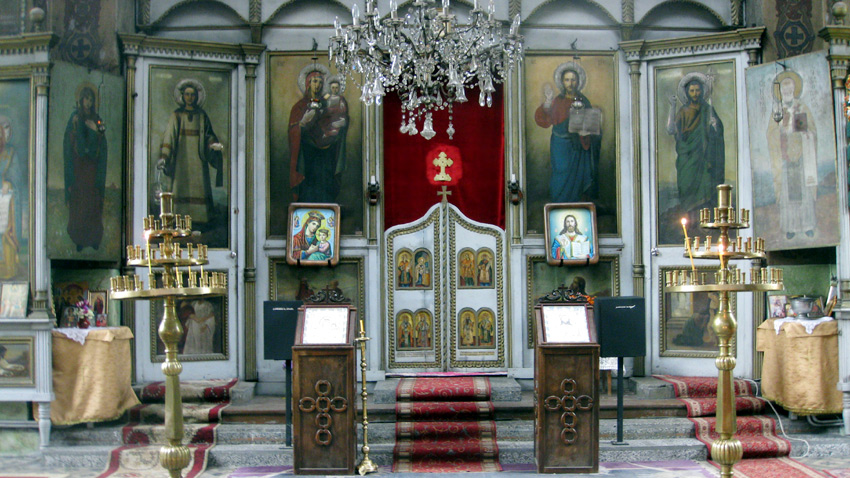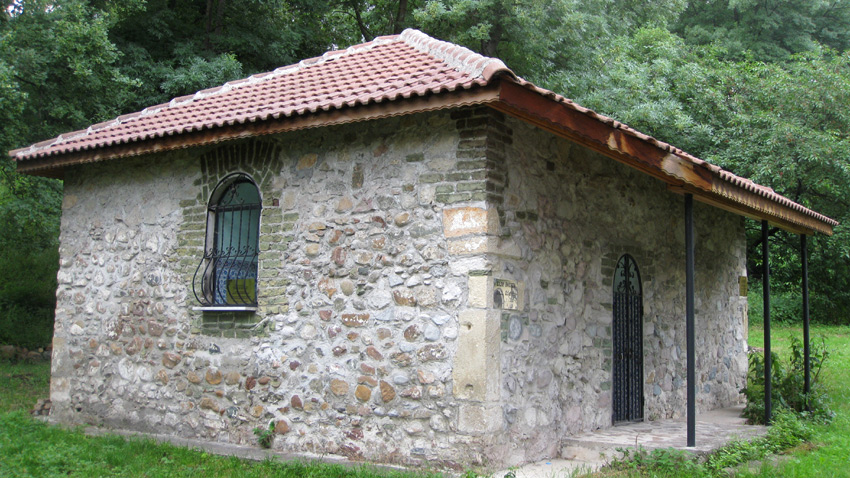 3
3
In the outskirts of Sofia, at the foot of Mount Vitosha where the city hubbub gradually dies down to give way to the spell-binding rhythm of nature, behind age-old trees there rises the streamlined silhouette of the St. Elijah the prophet church. History here seems to have come out of a book of bedtime stories, telling tales of the tolerance that has always thrived in our lands, tolerance that has always held the key to good will and peace.
As we cross the well-tended courtyard we find we have an escort - two friendly ginger cats. In the church we are welcomed by His Eminence Bishop Constantine of Marcianople. From him we find out that the foundation stone of the church was laid ten years after the country’s liberation from Ottoman domination in 1878.
“There are mineral baths here, in Knyazhevo, close to the church. In these baths Prince Alexander of Battenberg, elected first prince of Bulgaria in 1879, would come to bathe after the liberation”, Bishop Constantine begins his story. Enthralled by the remedial power of the water and the clean air, the Prince told Stefan Stambolov, then Prime Minister that it was here he wanted to build his residence. He also wanted a church and a post-office built so as to keep in touch with the Western world. But Alexander of Battenberg never actually put up a summer residence here. After the 1886 military coup, he was forced to abdicate. Nonetheless, work on the church’s blueprint, approved by the Prince himself continued and its foundations were laid on 20 July 1888. The construction work was completed in 1893, though its murals were painted much later – in the 1913-1919 period, in an academic style rather than following the religious canon. The central iconostasis was a personal gift from Stefan Stambolov. The church was consecrated by Parthenius, then metropolitan bishop of Sofia and the ceremony was attended by Stambolov and all cabinet ministers. In honour of the Prince of Battenberg the village – at the time these lands were outside the bounds of Sofia – was named Knyazhevo (derived from the word knyaz - prince). But before that…
 “Before that Knyazhevo was called Bali Efendi – named after a man who lived here, in this courtyard. At that time there was a small mosque here and this was waqf land, bequeathed to the Muslim temple. Bali Efendi himself was a Muslim monk, a 16th century dervish who tended to the health of the ordinary men and women using herbs. Many came to see him from all corners of Sofia region in the hope of a cure. He had Arabic books with all kinds of herb recipes and used them to tend to the ailing. So, Bali Efendi’s fame spread. And one more thing – he left his worldly belongings to be divided up equally among Turks and Bulgarians after his death. In his lifetime he would do good turns to Turks and Bulgarians. That is why people called him Bali Baba or Honey Father. It was his will to be buried here, in the courtyard, close to the mosque”, Bishop Constantine says.
“Before that Knyazhevo was called Bali Efendi – named after a man who lived here, in this courtyard. At that time there was a small mosque here and this was waqf land, bequeathed to the Muslim temple. Bali Efendi himself was a Muslim monk, a 16th century dervish who tended to the health of the ordinary men and women using herbs. Many came to see him from all corners of Sofia region in the hope of a cure. He had Arabic books with all kinds of herb recipes and used them to tend to the ailing. So, Bali Efendi’s fame spread. And one more thing – he left his worldly belongings to be divided up equally among Turks and Bulgarians after his death. In his lifetime he would do good turns to Turks and Bulgarians. That is why people called him Bali Baba or Honey Father. It was his will to be buried here, in the courtyard, close to the mosque”, Bishop Constantine says.
 It is over the ruins of that mosque that the St. Elijah church is thought to have been built. To make this possible, Ivan Todorov a local patriot went all the way to Istanbul to buy the land. Today, Bali Efendi’s grave is just meters from the church. But how can a Christian church and the grave of a dervish, where Muslims still come in the hope of a cure, exist side by side?
It is over the ruins of that mosque that the St. Elijah church is thought to have been built. To make this possible, Ivan Todorov a local patriot went all the way to Istanbul to buy the land. Today, Bali Efendi’s grave is just meters from the church. But how can a Christian church and the grave of a dervish, where Muslims still come in the hope of a cure, exist side by side?
“It is a question of tolerance. The Bulgarian people are tolerant and Orthodox Christians – twice as tolerant. Since the time the church was erected there has never been a problem with Muslims coming to Bali Baba’s grave even though it is inside the church courtyard, because true believers are tolerant. They always see the other man, whoever he may be, as a brother. Believers are well-intentioned, they feel no hatred of others. Orthodox Christians are gentle, as are Muslims who are true believers.”
Still, Bishop Constantine admits that years ago the tomb’s roof burnt down and that is was probably arson. However later it was restored and is today very well tended. A monument to the soldiers from Knyazhevo who lost their lives in the First and Second Balkan War (1912-1913) also rises in the church’s courtyard, there is also a water supply installation here that dates back to 1927.
English version Milena Daynova
Photos: Miglena Ivanova
T he Supreme Court of Cassation has given final judgement that the Bulgarian Orthodox Old Calendar Church must be registered in the register of religious denominations. This isthe first time a second Orthodox church will be registered, the..
The Arbanasi architectural reserve near Veliko Tarnovo is one of the most popular tourist destinations . The medieval monasteries and churches, including the Church of the Nativity, are particularly attractive. The churches of Arbanasi are museum sites..
On the third day of Christmas, December 27, the Bulgarian Orthodox Church commemorates the memory of Saint Stephen, the first Christian martyr. His name means "crown" or "wreath" and comes from the Greek "στέφανος" (stéphanos). It symbolizes victory..
All Souls' Day (Zadushnitsa in Bulgarian) is an important day for many Christians. On this day, we remember deceased relatives and loved ones. The first of..
Meatfare Sunday in 2025 will be remembered as a major celebration for the Bulgarian Orthodox Church and the entire Bulgarian community in the United..

+359 2 9336 661
